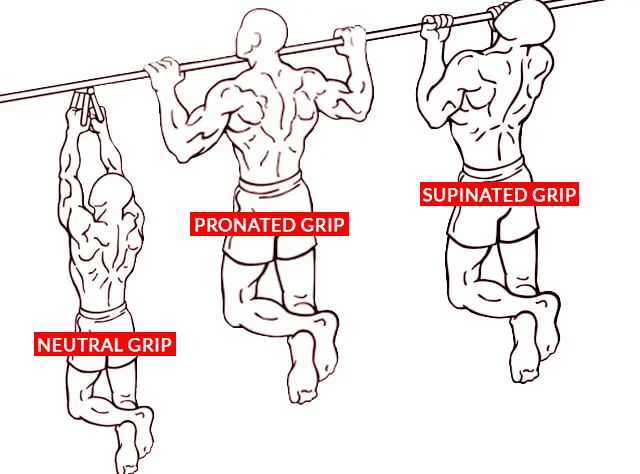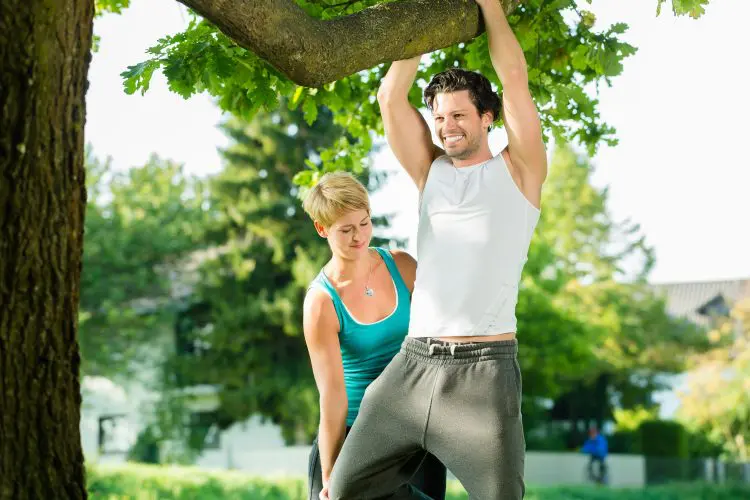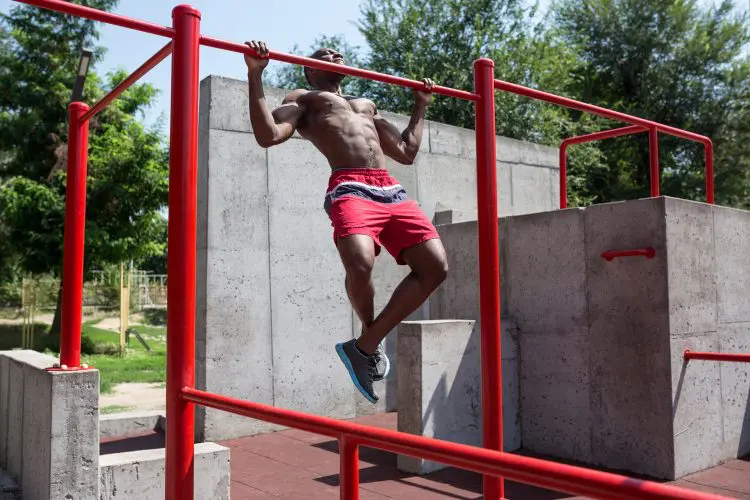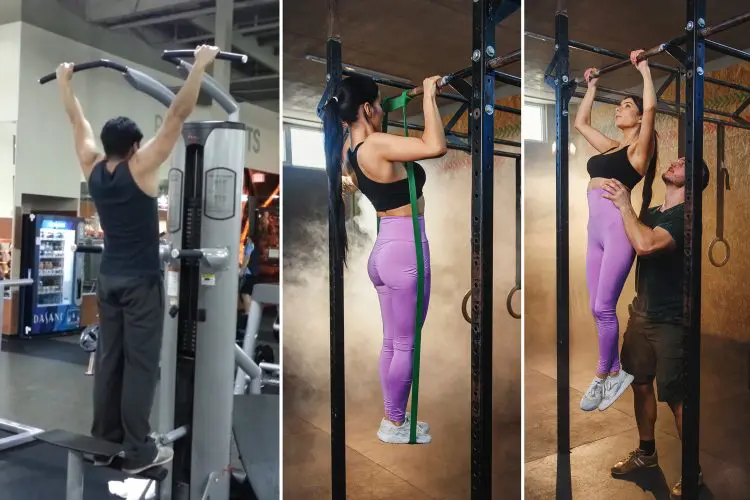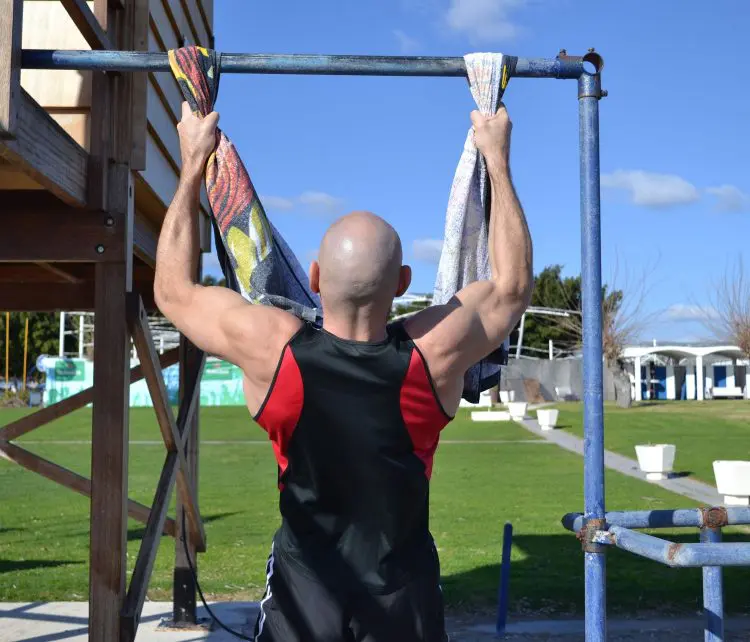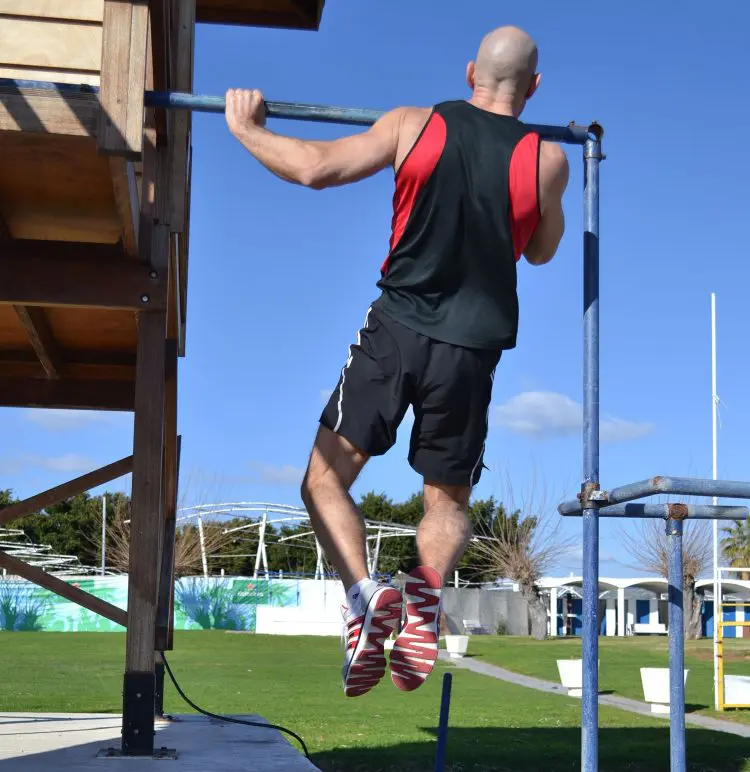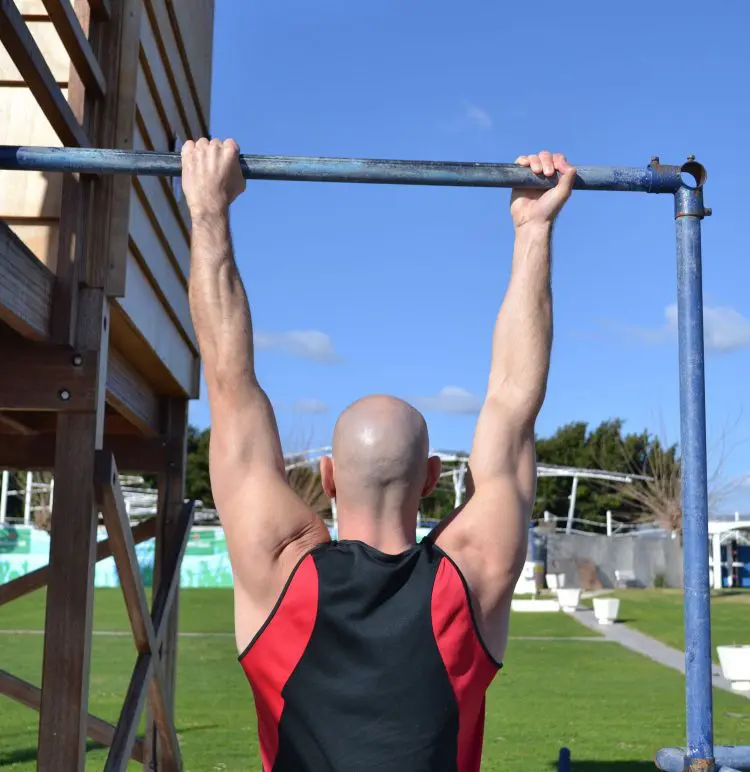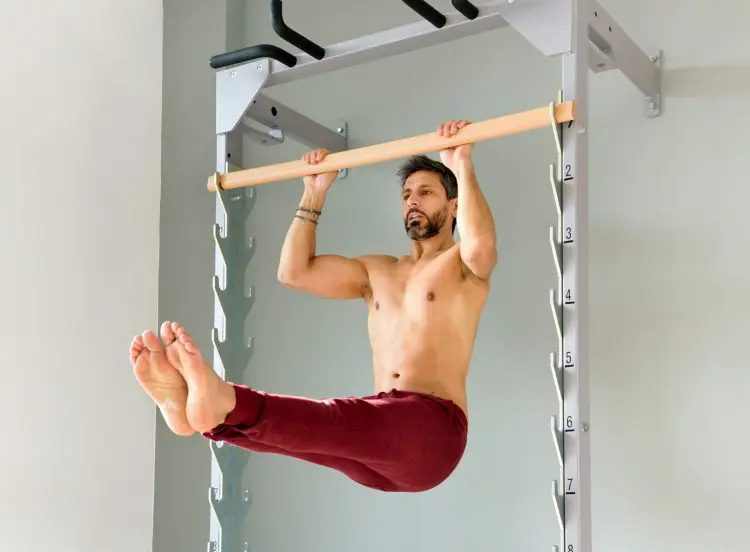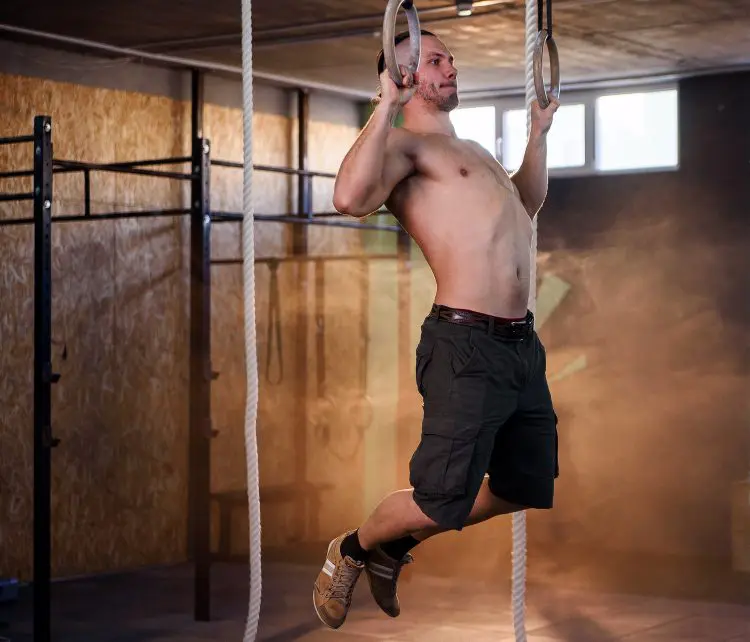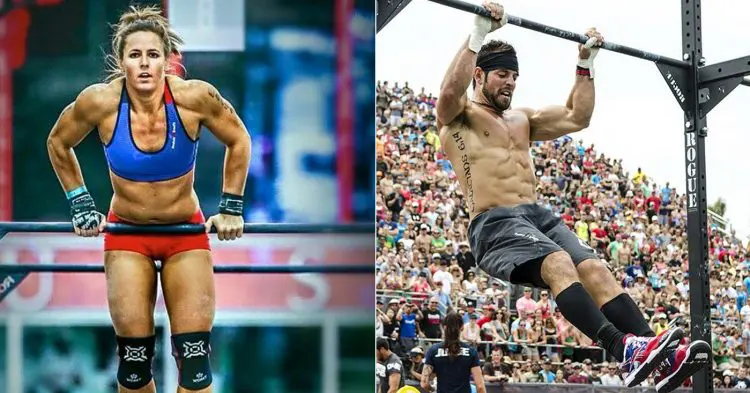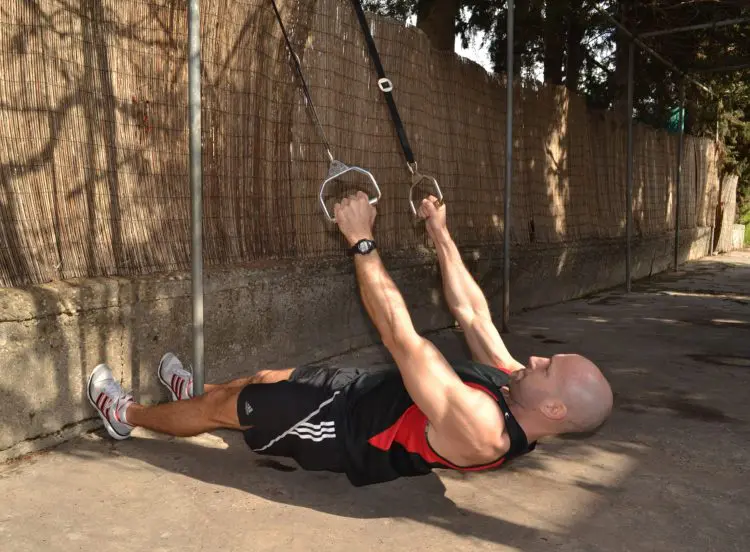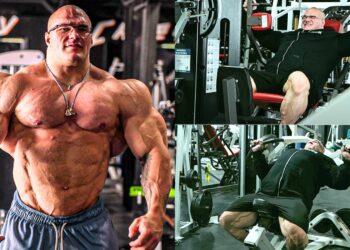If you want to build muscle mass and strength, your choice of exercise matters. Some exercises are definitely better than others! When it comes to building a bigger back, you need to include a combination of horizontal and vertical pulls in your workouts. This will ensure you develop both thickness and width.
But which is the best vertical pulling exercise? We’d like to suggest it’s chin-ups and pull-ups.
In this guide, we reveal how to do these awesome exercises, their advantages, and benefits, how to fix your performance faults, and how to become the king of chin-ups and pull-ups.
How to do Chin-Ups
To enjoy all the benefits discussed elsewhere in this article, you must do chin-ups correctly. Not only will you get better results, but you’ll also reduce your risk of injury. Follow these steps to ensure that each and every rep you perform is as beneficial and safe as possible.
- Hang from an overhead bar with an underhand, slightly wider than shoulder-width grip. Your arms should be straight. Pull your shoulders down and back and brace your abs. Bend your legs and cross your feet behind you. Alternatively, you can keep your legs and body straight.
- Lean back slightly, lift your chest, and bend your arms. Without swinging or kicking, pull your sternum up toward the bar.
- Think about leading with your elbows and drive them down and back to maximally contract your back.
- Pause at the top of the rep for a second (enjoy the view!) and then lower yourself back down. Descend with control; don’t just drop.
- Pause with your arms straight but don’t relax your shoulders. Keep them down and back.
- Pump out another rep!
For the most part, chin-ups should be done from a dead hang. In other words, you should pause briefly between reps to reduce momentum and make each rep as demanding as possible.
But, as you tire, you may find that a little kick or swing helps you to crank out a few more reps. However, you should still try to keep kicking and swinging to a minimum, as using these strategies too early in your set could make this exercise much less productive.
Level Up Your Fitness: Join our 💪 strong community in Fitness Volt Newsletter. Get daily inspiration, expert-backed workouts, nutrition tips, the latest in strength sports, and the support you need to reach your goals. Subscribe for free!
Chin-ups vs. Pull-ups
Chin-ups and pull-ups are often mentioned in the same breath and are also often confused. After all, they ARE very similar-looking exercises. However, there are enough differences that they are worth discussing separately.
While chin-ups feature a shoulder-width (or slightly narrower) supinated or underhand grip, pull-ups use a pronated or overhand, wider-than shoulder-width grip. This not only affects how these two exercises feel but also changes how the main muscles work, albeit only slightly.
The main muscles used in chin-ups and pull-ups are:
Latissimus dorsi – the muscles of your upper back. The lats are responsible for shoulder joint extension and adduction.
Biceps brachii – located on the front of your upper arm, the biceps flex your elbows.
Lower and middle trapezius – the muscles between and below your shoulder blades. Lower and mid traps are responsible for pulling your shoulders down and back, providing a stable platform for the lats and biceps to work from.
While both chin-ups and pull-ups provide these muscles with a great workout, they do so slightly differently.
In terms of joint action, chin-ups involve shoulder joint extension, while pull-ups involve more adduction. Both of these movements are mostly controlled by the lats, which is why chin-ups AND pull-ups are useful back builders.
However, the supinated grip with chin-ups increases biceps activation (1). If you look at the arm action in chin-ups, you’ll quickly see it looks a lot like doing barbell biceps curls. The only difference is that you’re curling yourself up to the bar instead of lifting a barbell.
In contrast, the arm action in pull-ups is more like a reverse barbell curl.
If you’ve ever done these two biceps exercises, you know that you can barbell curl more than you can reverse curl.
This means that chin-ups are a) better for building your biceps and b) put you in a biomechanically stronger position, so you should be able to do more reps or use more weight.
This is a significant advantage because the weak link in both chin-ups and pull-ups is the biceps. Your arms will almost always fail before your bigger, stronger lats. That means doing chin-ups instead of pull-ups should provide your lats with a more intense, productive workout.
Chin-ups also involve a larger range of motion than pull-ups. The wider you place your hands during pull-ups, the smaller the range of motion at the shoulders. This means, in theory, chin-ups could be the superior lat exercise too.
We say in theory because pull-ups appear to active the lats a little more than chin-ups. However, because your biceps are in a stronger position, you should be able to do more reps or lift more weight doing chin-ups compared to pull-ups. This mostly negates any slight increase in lats activation. For example, if you can do ten reps of chin-ups, but only eight reps of pull-ups, your lats will get a better workout despite chin-ups not hitting your lats quite as hard.
Both chin-ups and pull-ups are great exercises, and there is no reason not to include both of them in your workouts. But, for biceps and even lats strength and size, chin-ups are probably slightly superior.
However, that supinated grip can also be a source of elbow pain, especially if you have tight wrists or shoulders. For that reason, a lot of exercisers prefer neutral grip chin-ups over the fully supinated grip.
Also known as parallel grip chin-ups, this variation uses the same joint action (shoulder extension) as regular chin-ups but, with your palms turned inward, it places less stress on the elbows. It’s still a decent biceps exercise, but brachialis, another elbow flexor, is more active. For this reason, for many exercisers, neutral grip chin-ups are the best of these three exercises.
[Related: Pull-Ups Vs. Chin-Ups – Which One is Right for You?]
Chin-up and Pull-up Advantages and Benefits
If you take a moment to look at chin-ups and pull-ups, it’s clear that they both involve a similar movement to lat pulldowns. So, the question is, why not just do pulldowns? After all, they’re easier, and you can change the weights as required.
While lat pulldowns ARE a useful exercise, chin-ups and pull-ups offer some useful advantages and benefits that you don’t get from machine-based movements.
Anywhere, Anytime
To do chin-ups and pull-ups, all you need is a bar to hang from. You can do them at the gym, but you can also do them out in the wilds from a tree branch or at a park on the jungle gym. This means there are usually more opportunities to do chin-ups and pull-ups than lat pulldowns.
Ideal for Home Exercisers
Unless you’ve got plenty of space and a fair amount of money too, you probably won’t be able to equip your home or garage gym with a lat pulldown machine. In contrast, for just a few dollars, you can buy a doorway chin-up bar or buy a multifunctional power tower. If you want to build a bigger, stronger back at home, chin-ups and pull-ups are a better choice than lat pulldowns.
Time Efficiency
Chin-ups provide your lats and your biceps with a great workout. If you only have limited training time but still want to build impressive lats and biceps, chin-ups should be your go-to exercise. Add some dips or push-ups for a two-exercise workout that works virtually all of your upper body muscles.
Functional
Chin-ups and pull-ups are very functional exercises. That means they mimic everyday activities or sporting movements. In this instance, chin-ups and pull-ups replicate the action of climbing. Indeed, if you ARE a rock climber or are in the military and have to climb ropes or heave yourself over obstacles, chin-ups and pull-ups are both very valuable exercises.
When you do chin-ups, your hands remain stationary, and you use your muscles to move your body. This is how your muscles tend to work in nature. In contrast, when you do lat pulldowns, your body remains stationary. This is another reason that chin-ups and pull-ups are more functional than the machine-based alternative.
Increased Triceps Size and Strength
Yes, that’s right, chin-ups work your biceps AND triceps. That’s because chin-ups involve shoulder extension, and the triceps are one of the muscles responsible for this joint action. Chin-ups work the long head of the triceps in much the same way that pullovers do.
Admittedly, chin-ups aren’t the best triceps exercise. The most effective way to work your triceps is through elbow extension, i.e., skull crushers, pushdowns, etc. But they’ll get enough stimulation to maintain the size and strength of the long head of your triceps.
More Core Activation
We’ve mentioned already that, to get the most from chin-ups and pull-ups, you need to try and keep your legs relatively still and stable. Keeping your lower body stationary means an increase in core activation. It’s not uncommon to feel your abs as well as your back and biceps after an intense set of chin-ups. Core activation increases if you do weighted chin-ups and pull-ups.
Lots of Variations to Try
When it comes to chin-ups and pull-ups, a lot of people just grab an overhead bar and start pumping out the reps. While such a simple approach can work, you’ll probably get better results if you include more variation in your workouts. The good news is that there are lots of different ways to do chin-ups and pull-ups, and we’ve listed the best a little further down this article.
Super Flexible Exercise
Can be modified to suit beginner, intermediate, and advanced exercisers – Just like lat pulldowns, chin-ups and pull-ups can be made easier or harder to suit your current fitness goals. Don’t dismiss this exercise just because you can’t lift your own body weight; there are ways to make these exercises accessible to even beginner exercisers.
More Overload Available
Most lat pulldown machines top out at about 200-300lbs of resistance. But what if you are stronger than this? Chin-ups and pull-ups offer more resistance, and you can easily strap on some extra weight to increase the load.
Chin-up and Pull-up Faults and How to Fix Them
To enjoy all of the benefits that chin-ups and pull-ups have to offer, you must perform them correctly. If you don’t, you could end up wasting a whole lot of time and energy and even get injured. Here are the most common chin-up and pull-up faults and how to fix them.
Not Starting Each Rep From a Dead Hang
In the same way that most types of deadlifts should start with the barbell resting on the floor, chin-ups and pull-ups should start from a dead hang. This doesn’t mean you can relax between reps; your shoulders should still be pulled down and back. However, your arms should be extended, and your body mostly motionless at the bottom of each rep.
This will stop you bouncing between reps, leading to injury and making your workout less productive. Get into the habit of pausing for a second or two at the bottom of each rep.
Not Getting Your Chin Over the Bar
They’re called a chin-up for a reason! You’ll get better results from this exercise if you pull your chin up and over the bar. Don’t just tip your head back to lift your chin as high as possible. Instead, look straight ahead and pull your upper chest to the bar to ensure your chin reaches the desired height.
Going from a full stretch to chin above the bar increases your range of motion, ensuring each rep is as productive as possible. Don’t be a half-repper; go from a dead hang to chin above the bar for most of your reps.
Using Too Much Momentum
CrossFit athletes use a technique called kipping to help them do more pull-ups and chin-ups or do their reps faster. As CrossFit workouts are usually against the clock, this makes a lot of sense.
However, if you are doing chin-ups or pull-ups to get bigger or stronger, more momentum is the last thing you need. Kipping will take the tension off the target muscles, making your workout less effective. Also, kipping puts a lot of stress on your shoulders, elbows, and lower back and could cause injury.
Starting each rep from a dead hang will reduce momentum, and you should do your best to avoid using your legs to help you get your chin over the bar. The only acceptable exception for this is the last rep or two of your set when you are approaching failure but aren’t quite ready to quit.
You Lack the Basic Strength to do Chin-ups and Pull-ups Properly
If you are a beginner or are an experienced exerciser but a little on the heavy side, you may not be strong enough to do these exercises correctly. The good news is that there are several ways you can fix this fault and develop the strength necessary to do chin-ups and pull-ups, such as band-assisted and negative reps.
For band-assisted chin-ups, loop a strong exercise band over your bar and then stand or kneel in it. The band will support some of your body weight and also help drive you up from full arm extension. Work from a strong band to a weaker one as you progress, eventually weaning yourself off bands altogether when you are ready to do them unaided.
Alternatively, you can use an assisted pull-up/dip machine at the gym.
For negative reps, you focus on lowering yourself down and not pulling yourself up. You are stronger eccentrically than concentrically. In other words, you can lower more weight than you can lift. Just because you can’t pull yourself up doesn’t mean you can’t lower yourself down under control.
A few weeks of negative reps should develop the strength necessary to do your first chin-up or pull-up.
To do negative reps, place a bench or step under your pull-up bar. Climb up, grab the bar as usual, and then contract your muscles with your arms bent and core braced. Lift your feet up and then lower yourself under control. Use your legs, climb back up, and repeat. End your set when you are no longer able to control your descent.
Not Leading with your Elbows
In an effort to do more (or any!) chin-ups or pull-ups, many exercisers focus too much on their biceps. While there is no escaping the importance of the biceps in these exercises, you’ll get better lat recruitment if you think more about driving your elbows down and back.
This will reinforce the mind-muscle connection with your lats, which are the target muscles and also responsible for generating the most force. Drive your elbows down and back, and you should see your performance improve.
Not Keeping your Shoulders Down and Back
Successful chin-ups and pull-ups require a stable upper back. If you allow your shoulders to move up or forward, your lats and biceps lose the stable platform they need to generate maximal force. In addition, losing stability increases shoulder stress and could result in injury.
Level Up Your Fitness: Join our 💪 strong community in Fitness Volt Newsletter. Get daily inspiration, expert-backed workouts, nutrition tips, the latest in strength sports, and the support you need to reach your goals. Subscribe for free!
Make sure you keep your shoulders down and back during each rep. Do this by imagining you are “putting your shoulder blades in your back pockets” and also ensuring that you try to touch the bar with your chest and not just your chin.
Overextending your Lumbar Spine
While you need to lift your chest and pull your shoulders back, you should not allow your lumbar spine to overextend. Overextending your lower back increases the stress on your intervertebral discs and the facet joints of the spine, which could cause injury.
A slightly arch is acceptable and necessary, but you could hurt yourself if your back is overextended. Keep your core engaged to prevent lumbar hyperextension.
Programming for Hypertrophy
Just doing chin-ups and pull-ups will help your back and biceps grow, but you’ll get better results if you train specifically for hypertrophy. Apply the following information to your chin and pull-up workouts to make them as productive as possible:
- Focus on the 6-12 rep range – muscles tend to grow best when you train in the 6-12 rep range. It’s okay to work outside this range occasionally, such as doing five sets of five, but if hypertrophy is your goal, the 6-12 rep range is generally considered to be the best. Rest 60-90 seconds between sets.
- Train to failure – unlike squats and bench presses, where training to failure can be dangerous, you can do chin-ups and pull-ups to failure with much less risk of serious injury. Training to failure can increase muscle growth. Simply rep out until you cannot do another rep with good form, i.e., cannot get your chin above the bar.
- Use appropriate weights – if you can do more than 12 reps, you may need to increase the weight to bring you back into the productive 6-12 repetition range. This is best done by wearing a weighted vest or a chin/dip belt. That way, you can progress your chin-up and pull-up workouts without resorting to doing high reps. There are also more difficult chin-up and pull-up variations to try.
- Try greasing the groove – to get the most from chin-ups and pull-ups, you need to be proficient at them. To be proficient at them, you need to do them more than the usual 1-2 times a week. Boost your chin-up and pull-up performance by greasing the groove, or GTG for short. GTG involves doing lots of micro-sets to accumulate a high volume of reps without training to failure. For example, if you have a doorway pull-up bar at home, you might do 10-15 sets of 3-5 reps per day to clock up as many as 75 reps. Over time, this significant volume of low-intensity training will have a noticeable effect on your pull-up performance, as well as your muscle size.
- Stretch your lats between sets – studies suggest that interset stretching may increase muscle strength and size (2). The easiest way to stretch your lats is to simply hang from your pull-up bar with a narrow, overhand grip. 20-30 seconds should suffice. Stretching between sets increases muscle tension and time under tension, which may make your workout more productive. However, some people find that interset stretching leads to a drop off in performance, so you’ll need to try it to see if this method works for you.
- Try pre and post-exhaust – your biceps invariably fail first during pull-ups and chin-ups. This can leave your lats under-stimulated. Fix this problem by doing an isolation exercise for your lats immediately before or after your chin-ups and pull-ups. Pre and post-exhaust are types of training systems.For example, before you do your set of chin-ups, do a set of dumbbell pullovers. This means you’ll start your set with tired lats, but your biceps will still be rested. Alternatively, do something like straight arm pulldowns after your set of chin-ups to finish your lats off and work around your tired biceps.
Chin-up and Pull-up Variations and Alternatives
Chin-ups and pull-ups are fantastic exercises, but that doesn’t mean they’re the only exercises you can use to build a bigger back and biceps. In fact, they’re just one of many movements you can use to train your upper body. Use the following variations and alternatives to keep your workouts fresh and interesting.
1. Towel Grip Chin-ups / Pull-ups
This chin-up/pull-up variation is a great way to develop a stronger grip. It’s especially useful for rugby players, wrestlers, MMA fighters, and climbers. It also replicates the gripping demands of climbing a rope, making it useful for military personnel too.
To do this exercise, loop two towels over your pull-up bar. Use an underhand, neutral, or overhand grip as preferred. Grip the ends of the towels as tightly as you can and start cranking out the reps. Don’t be surprised if you can’t do as many as usual!
2. Side to Side Pull-ups
This pull-up variation is a useful exercise for rock climbers, who often have to pull themselves up sideways and not just vertically. It’s also a good exercise for starting to develop the strength necessary for one-arm chin-ups.
To do it, grab the bar with an overhand, shoulder-width grip. Bend your arms and pull your chin up and over to one hand. Descend and then pull yourself up and over to the other side. Continue alternating sides for the duration of your set.
Alternatively, once you’ve pulled your chin up and over to your hand, move across the bar and touch your chin the other side before descending. If using this method, make sure you alternate which hand you touch first.
3. Mixed-grip Pull-ups / Chin-ups
Can’t decide between chin-ups and pull-ups? Why not do both! Use a mixed grip to do pull-ups with one arm and chin-ups with the other. Alternate arms set by set.
4. Plyometric Chin-ups and Pull-ups
If you are looking for the ultimate challenge in pull-ups and chin-ups, this is the exercise for you. Start your rep as usual but pull yourself up as fast as you can. Release the bar as you feel your body go weightless at the top of your rep. Grab the bar as you start to come back down and engage your muscles to control your descent.
Needless to say, this is a VERY advanced chin-up and pull-up variation, and you should not try it unless you have entirely mastered more basic variations.
5. Single-arm Chin-ups
Just because you can do ten regular chin-ups does not mean you’ll be able to do five using only one arm! Some people will never be able to do single-arm chin-ups, as it’s an exercise that requires not just lots of strength but great genetics too.
But, that doesn’t mean you shouldn’t train and try doing one-arm chin-ups. If nothing else, your training will undoubtedly increase your regular chin-up performance.
One way to work up to doing one-armed chin-ups is to grip the bar with one hand and a towel with the other. As you get stronger, move your hand further down the towel to reduce your purchase and your ability to use it.
Alternatively, you can use a resistance band to offset some of your weight.
6. L-sit Chin-ups and Pull-ups
Chin-ups and pull-ups use your abs, but their involvement is not all that significant. If you’ve got a reasonably strong core, you might not even feel them working. L-sit chin-ups and pull-ups are much more core-centric.
To do these variations, grab the bar as usual, but then lift your legs and hold them parallel to the floor. Keep your legs up for the duration of your set, or raise and lower them rep by rep.
You can also bend your legs and tuck your knees to your chest, which will be considerably easier but will still increase core activation.
7. Chin-up / Pull-up Burpees
Pull-ups and chin-ups are great upper body exercises that you can use to build strength and muscle size. But, if conditioning is important to you, they can also be incorporated into burpees to make a full-body fitness exercise.
To do chin-up/pull-up burpees, stand beneath your pull-up bar. Squat down, place your hands on the floor and jump your feet out and back into the push-up position. Do a single push-up. Jump your feet back up to your hands and then leap into the air. Grab the pull-up bar with an overhand or underhand grip as preferred, and pull your chin up and over the bar. Descend under control, drop the floor, and repeat.
8. Gymnastic Ring Chin-ups
A lot of pull-up related joint pain is caused by locking your arms into one position. Using gymnastic rings instead of a fixed bar means your hands can rotate naturally, taking stress off your wrists and elbows.
Gymnastic rings don’t have to be expensive, and there are models designed specifically for hanging from chin-up and pull-up bars.
9. Muscle-ups
Muscle-ups combine a powerful pull-up with a dip to create an all-in-one upper body exercise. Needless to say, muscle-ups are not easy, and you should be proficient at pull-ups and dips to attempt them. But, once you’ve mastered it, muscle-ups are an impressive feat of strength and athleticism.
Muscle-ups can be done using gymnastic rings or a straight bar. Just make sure you have enough space above you so that you won’t hit your head on the ceiling!
[Related: How to Master the Bar Muscle Up]
10. Incline Rows
Incline rows are easier than chin-ups and pull-ups. You do this exercise with your feet on the floor, which takes the weight off your arms. It’s a good preparatory exercise for chin-ups and pull-ups, as it uses many of the same muscles. It’s also useful for mimicking movements like bent-over barbell rows and seated cable rows using just your bodyweight.
Incline rows can be done using a Smith machine or bar in a power rack set to about waist-height or using gymnastic rings or a suspension trainer, such as a TRX.
To do this exercise, set your bar or handles to the desired height and then sit below. Grab your handles with an overhand, underhand, or neutral grip as preferred. Lean back and, with your arms and legs straight, lift your hips off the floor.
Bend your arms and pull your chest up, so it’s level with your hands. Keep your core braced and your body straight. Extend your arms and repeat.
Make this exercise easier by raising your bar/handles or harder by placing your feet on a bench. You can also rest a weight plate on your hips or wear a weighted vest.
Note: You can make any of these chin-up and pull-up variations harder by wearing a weighted vest or a chin/dip belt.
How to Improve Chin-up and Pull-up Performance
Assistance Exercises and Methods to Improve Chin-up and Pull-up Performance – Just doing chin-ups and pull-ups regularly should make you better at doing them. But, if you want to improve your performance faster, there are some exercises and methods you can use that will have a specific performance-boosting effect.
1. Barbell Curls
Chin-ups might be primarily a back exercise, but your biceps still play a vital role. If your biceps are weak, you’ll always find them harder than they need to be. If your biceps are your weak link, make sure you spend some extra time training them in isolation. Barbell curls are probably the best biceps exercise you can do for better chin-ups.
[Related: How to do the barbell curl]
2. 1 ½ Rep Chin-ups and Pull-ups
This simple chin-up/pull-variation can be very humbling. If you are looking for a way to make both of these exercises much harder but don’t want to resort to wearing a weighted vest, this is the one to choose. It increases time under tension so that, when you return to doing chin-ups and pull-ups the usual way, they’ll feel a whole lot easier.
To do 1 ½ rep chin-ups and pull-ups, adopt your preferred grip and pull your chin up and over the bar. Next, descend about halfway down, so your elbows are bent to 90-degrees.
Pull yourself back up to the bar, and then finally descend all the way down until your arms are fully extended. That’s one rep; keep going! And yes, that wicked pump in your lats is entirely normal with this variation.
3. Paused Chin-ups and Pull-ups
Powerlifters use purposeful pauses to help them develop the strength they need to blast through sticking points and lift more weight. You can also use pauses to increase time under tension for muscle growth and made regular chin-ups and pull-ups easier.
There are three places you can pause to add extra intensity to your chin-up and pull-up workouts.
- Halfway up
- At the top of each rep
- Halfway down
Pause in any of these positions for 1-3 seconds.
4. Heavy Negative-only Chin-ups and Pull-ups
Weighted pull-ups are one of the best ways to develop pull-up strength. However, you are limited by your concentric strength, i.e., the amount of weight you can lift. You are significantly stronger eccentrically than you are concentrically and can train with heavier weights by doing eccentric or negative-only reps.
Wearing a weighted vest or using a chin/dip belt, place a step or bench under your pull-up bar. Climb up and get into the top position of the chin-up/pull-up. Lift your legs and use your arms to lower yourself down smoothly and under control. Climb back up and repeat. Stop your set when you are no longer able to control your descent.
Be warned; as useful as eccentric-only training can be, it’s also a common cause of post-exercise muscle soreness. As you’ll be using much more weight than usual with this exercise, you should expect some deep muscle pain during the 48-72 hours following your workout.
5. Super Slow Chin-up / Pull-up
This is another simple, no-frills way to make your chin-up and pull-up workouts harder and, therefore, more effective. A few workouts using this method will make regular pull and chin-ups feel much easier. This exercise also keeps your muscles under tension for longer, which should enhance hypertrophy.
Doing either pull-ups or chin-ups, start your rep and take 30 seconds to pull your chin up and over the bar. Do not stop mid-rep. Your aim is to keep moving, albeit very slowly. Lower yourself down, taking 30 seconds to descend.
One rep should suffice, but if you feel you could have done more, try taking 35, 40, or 45 seconds to pull yourself up and come back down. Alternatively, try this exercise while wearing a weighted vest.
Wrapping Up
Back and biceps exercises don’t come much better than chin-ups and pull-ups. You only have to look at the upper body development of many male gymnasts to see just how effective chin and pull-ups are for building muscle size and strength.
Unlike so many other productive compound exercises, chin-ups and pull-ups are also very straightforward exercises, and you don’t need a whole lot of equipment to do them. A tree branch will suffice! This makes them an excuse-free exercise that you can do almost anywhere and anytime. It’s no wonder they’re so popular in the military.
Whether you are working up to your first chin-up or pull-up or looking for ways to get even more from these exercises, our guide will help.
References:
1 – PubMed: Surface electromyographic activation patterns and elbow joint motion during a pull-up, chin-up, or perfect-pullup™ rotational exercise https://pubmed.ncbi.nlm.nih.gov/21068680/
2 – PubMed: Interset Stretching vs. Traditional Strength Training: Effects on Muscle Strength and Size in Untrained Individuals https://pubmed.ncbi.nlm.nih.gov/30688865/
Interested in measuring your progress? Check out our strength standards for Bench Press, Push Ups, Dumbbell Pullover, and more.


